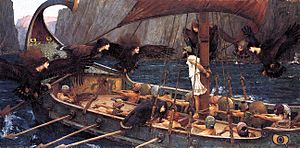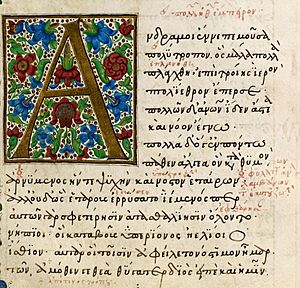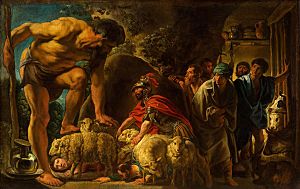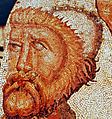Odyssey facts for kids
The Odyssey is a very old and famous Greek poem. It was written by a poet named Homer. It's like a sequel to another famous poem, the Iliad. Long ago, it was a story told out loud in ancient Greece, around the 11th century BC. The main hero of this poem is Odysseus. In Latin, people called him Ulysses. The story is a myth, which means it's a legendary tale, not a true historical event.
The poem tells the exciting story of Odysseus's long journey home. He travels for ten years to get back to his island, Ithaca, after the Trojan War. The Trojan War itself is the main topic of the Iliad. While Odysseus is away, his wife, Penelope, has to deal with many men who want to marry her. At the same time, his son, Telemachos, is searching for his missing father.
On his way home, Odysseus and his men face many dangers and fight scary monsters. Here are some of the main places he visits and the creatures and people he meets:
- the Kikones
- the Lotus Eaters
- the Cyclops Polyphemus
- Aeolus, King of the winds
- the Laistrygones
- the sorceress Circe
- the Underworld
- the Sirens
- the sea monsters Scylla and Charybdis
- Helios' cattle
- the nymph Calypso
- the Phaeacians
Contents
Odysseus's Amazing Journey
Meeting the Cyclops
During his trip home, Odysseus and his men land on an island. This island is home to the Cyclops named Polyphemus. The Cyclops are giant, one-eyed creatures. Odysseus and his men go into Polyphemus's cave because they see sheep, cheese, and milk.
Polyphemus catches them and eats some of Odysseus's men. Odysseus is very clever. He tricks the Cyclops and blinds him. This allows Odysseus and his remaining men to escape. After being blinded, Polyphemus prays to his father, Poseidon, who is the god of the sea. He asks Poseidon to make sure Odysseus never gets home. If Odysseus is fated to return, Polyphemus wishes he would lose all his men and his ship. He also wishes Odysseus would find trouble waiting for him at home. This prayer sets up the entire story of the Odyssey.
The Dangerous Sirens

Odysseus and his ship must sail past the island of the Sirens'. The Sirens were mythical creatures. They sang incredibly beautiful songs. Sailors who heard their songs would try to go to them. But their ships would crash, and the sailors would die.
Odysseus knew about this danger. He told his men to put wax in their ears. This way, they would not hear the Sirens' enchanting song. He also told his men to tie him tightly to the ship's mast. He wanted to hear the song, but he didn't want to be able to go to the Sirens. His men could watch him. When he became calm again, they would know the danger had passed. Then they could take the wax out of their ears and free Odysseus.
Staying with Calypso
After escaping many dangers at sea and losing all his men, Odysseus washes up on the island of Ogygia. A beautiful nymph named Calypso lives on this island. Odysseus stayed with her for seven long years.
Then, the god Hermes arrived. He told Calypso that the other gods had ordered her to let Odysseus go. Calypso offered Odysseus immortality, meaning he would live forever, if he stayed with her. But Odysseus missed his wife, Penelope, and wanted to go home. So, he built a raft and left Calypso's island.
The Kind Phaeacians
After another storm at sea, Odysseus lands on the island of the Phaeacians. There, the king's daughter, Nausicaä, finds him. Nausicaä takes him to her father's palace. Her father is King Alkinoos. While staying with the Phaeacians, Odysseus tells them the amazing story of his entire journey. After hearing his tale, King Alkinoos gives Odysseus a ship and sends him safely home to Ithaca.

Finally Home to Ithaca
While Odysseus was away, Penelope had been using a clever trick to keep the men who wanted to marry her away. These men, called suitors, wanted to take over Odysseus's kingdom. Penelope promised, "I will choose a husband when I have finished weaving this cloth." The cloth was supposed to be a burial cloth for Odysseus's father. However, every night, her servant would secretly undo the weaving from the day before. This trick kept the suitors waiting for a very long time.
Odysseus finally returns to Ithaca. He disguises himself as an old beggar so no one recognizes him. He goes to his home and meets his son, Telemachus. Together, they fight and kill all the suitors who were trying to marry Penelope and take over their home. Later, the families of the dead suitors come to get revenge on Odysseus. But the goddess Athena steps in. She helps Odysseus by making the families stop fighting and give up.
- The English word odyssey means a long and adventurous journey. This word comes from this very poem.
- The Roman name for Odysseus is Ulysses.
- James Joyce wrote a book in 1922 called Ulysses. It is based on Homer's poem, but it is a very different story.
Images for kids
-
Charles Gleyre, Odysseus and Nausicaä
-
Odysseus Overcome by Demodocus' Song, by Francesco Hayez, 1813–15
-
Odysseus discovers Penelope has devised tricks to delay the suitors whilst he has been away: Penelope and the Suitors by John William Waterhouse
-
Portrait by the Italian painter Domenico Ghirlandaio of the Greek Renaissance scholar Demetrios Chalkokondyles, who produced the first printed edition of the Odyssey in 1488
-
Front cover of James Joyce's Ulysses
See also
 In Spanish: Odisea para niños
In Spanish: Odisea para niños













